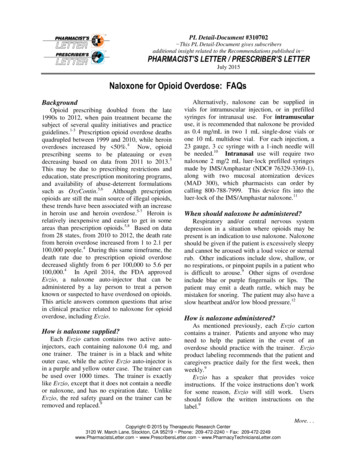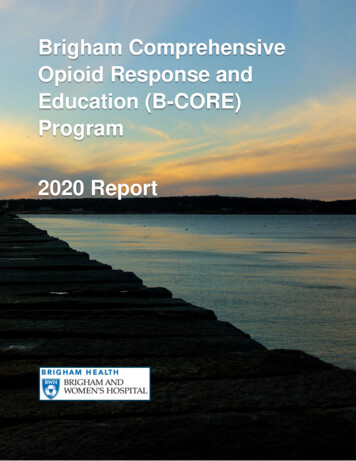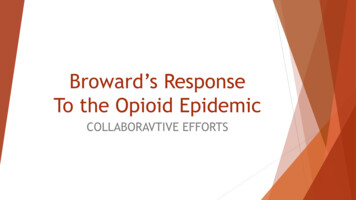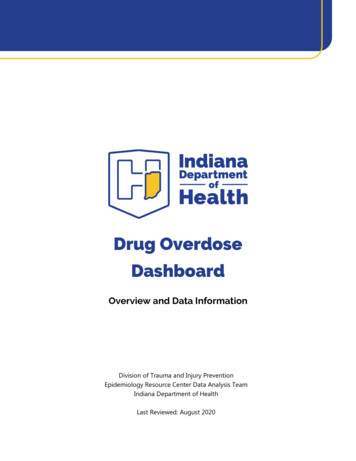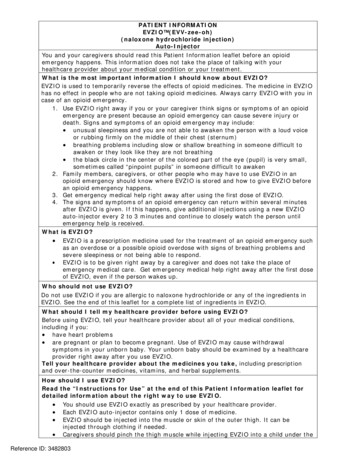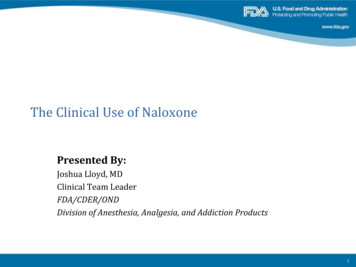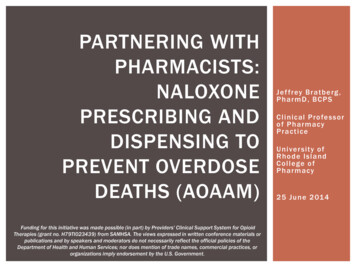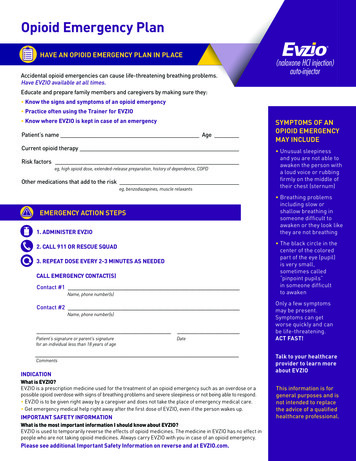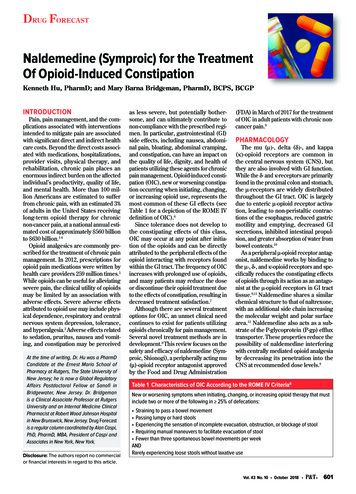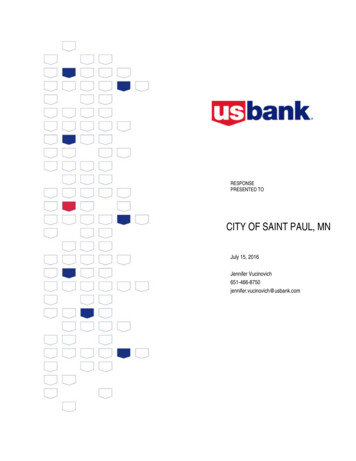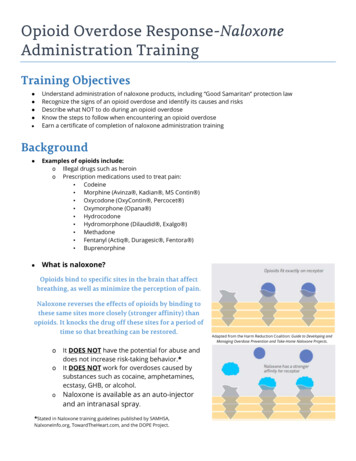
Transcription
Opioid Overdose Response-NaloxoneAdministration TrainingTraining Objectives Understand administration of naloxone products, including “Good Samaritan” protection lawRecognize the signs of an opioid overdose and identify its causes and risksDescribe what NOT to do during an opioid overdoseKnow the steps to follow when encountering an opioid overdoseEarn a certificate of completion of naloxone administration trainingBackground Examples of opioids include:o Illegal drugs such as heroino Prescription medications used to treat pain: Codeine Morphine (Avinza , Kadian , MS Contin ) Oxycodone (OxyContin , Percocet ) Oxymorphone (Opana ) Hydrocodone Hydromorphone (Dilaudid , Exalgo ) Methadone Fentanyl (Actiq , Duragesic , Fentora ) Buprenorphine What is naloxone?Opioids bind to specific sites in the brain that affectbreathing, as well as minimize the perception of pain.Naloxone reverses the effects of opioids by binding tothese same sites more closely (stronger affinity) thanopioids. It knocks the drug off these sites for a period oftime so that breathing can be restored.oooIt DOES NOT have the potential for abuse anddoes not increase risk-taking behavior.*It DOES NOT work for overdoses caused bysubstances such as cocaine, amphetamines,ecstasy, GHB, or alcohol.Naloxone is available as an auto-injectorand an intranasal spray.*Stated in Naloxone training guidelines published by SAMHSA,NalxoneInfo.org, TowardTheHeart.com, and the DOPE Project.Adapted from the Harm Reduction Coalition: Guide to Developing andManaging Overdose Prevention and Take-Home Naloxone Projects.
Risks factors for an Overdose Mixing opioids with other drugs, especially alcohol and benzodiazepines (Xanax , Valium , Ativan )If a person hasn’t been taking an opioid for an extended period of time and then starts taking it again, suchas after being in:o Jailo Detox programo Rehab treatment facilityUsing these medications while aloneRecognizing an Overdose An overdose happens when a toxic amount of a drug (or combination of drugs) overwhelms the body andcauses it to shut down. Opioid drugs or “downers” cause this by slowing or stopping breathing, which willeventually cause the heart to stop.Overdoses often happen slowly, over the course of several hours.oIf someone seems extremely “high” but is still awake and able to walk: Get them up and walking around Keep them talking to youTHIS MAY PREVENT THE PERSON FROMCROSSING “THE LINE” INTO AN OVERDOSESIGNS OF OVERMEDICATION Heavy nodding, sleepiness, but responsive Difficulty staying awake Slurred or slow speechSIGNS OF OVERDOSE – “the line” Unresponsive to shouting, pain stimulation Unconsciousness Slow and shallow breathing or NOT breathing Pale, clammy skin, loss of color Blue, purple, or gray face, especially around lips/fingernails Faint or NO pulse Extremely small “pinpoint” pupilsAdapted from Naloxone guidelines published by SAMSHA, NaloxoneInfo.org, TowardTheHeart.com, and the DOPE Project.oIf the person becomes unconscious, follow the steps outlined in this training.What NOT to do During an Overdose DO NOT put the individual into a cold bath or shower. They could drown.DO NOT inject the person with any substance other than naloxone (saltwater, milk, “speed”, etc.).This does not work.DO NOT try to make the person vomit or give them something to eat or drink. They could choke.DO NOT give over-the-counter drugs or vitamins (No-Doz, Niacin). These do not help.
What TO DO During an OverdoseStep 1: Try to Maintain Responsiveness Call the person’s name Shake the person Utilize the “sternum rub”o Make a fist and use the middle joints of your fingers (not theknuckles) to firmly rub the center of the person’s chest to wakethem upStep 2: Administer Naloxone* Administer a naloxone product per package insert instructions.Step 3: Dial 911* If there is no response, CALL 911o Stay with person until emergency medical services arriveo Tell 911: Address or location of where to find the person If they are not breathing If you gave naloxone and how much What medications the person took if you know*Steps 2 and 3 can occur interchangeably depending on which can be achieved more quickly*** If not trained to give or comfortable giving CPR please skip to Step 5 **Step 4: Give Chest Compressions** Provide support to help blood circulation and oxygen deliveryo Place one hand over the other on the person’s sternumRetrieved Aug 23, 2016 from ioning-your-hands-for-chestcompressions
Retrieved Aug 23, 2016 from nceo Repeatedly compress the chest at least 2 in (5 cm) for 2 minutes Put them on their back Pull the chin forward to keep the airway open put one hand on the chin, tilt the head back, and pinch thenose closed Make a seal over their mouth with yours and breathe in two breaths. The chest, not the stomach, shouldrise Give one breath every 5 seconds
NALOXONE NASAL ATOMIZER1. Take YELLOW caps off the needleless syringe2. Grip the clear plastic wings and gently screw the WHITE cone (nasal atomizer) onto the barrel ofthe syringe3. Take the RED cap off the naloxone vial4. Screw the naloxone vial into the barrel of the syringe without pressing down hard5. Tilt the person’s head back and put the WHITE cone into one nostril Give a short, firm push on the end of the syringe Spray one-half of the dosage into each nostril If the person’s symptoms return after the first dose of naloxone, anadditional dose may be given after 2 to 3 minutes6. If another dose needs to be given, a new auto-injector must be used
EVZIO o EVZIO is an auto-injector that gives voice instructions for each of the steps A practice or “trainer” device is included. As part of your opioid emergency plan, practice using the Trainer for EVZIO.Make sure your family or caregiver also practice using the EVZIO training device. If the audio instruction system malfunctions, the device will still deliver the doseif the printed directions are followed.1. Pull EVZIO from outer case2. Pull off the RED safety guard
PULL FIRMLY – the safety guard is made to fit tightlyDo not replace the RED safety guard after it is removedTo reduce the chance of an accidental injection, do not touch the BLACKbase of the auto-injector, which is where the needle comes outIf an accidental injection happens, get medical help right away3. Place the BLACK end of the product on the outer thigh It can be given through clothingIn children under 1 year of age, the person giving Evzio should pinch thethigh muscle while administering the dose A distinct “click and hiss” sound will be heard – this is normal and meansthat it is working correctlyKeep firmly pressed on the thigh for 5 seconds after you hear the clickand hiss soundThe needle will inject and then retract back into the auto-injector and isnot visible after use 4. After use, place the auto-injector back into its outer case. The BLACK base will lock into placeThe voice instruction system will state that EVZIO has been used and theLED will blink redThe RED safety guard cannot be replacedThe viewing window will no longer be clear – You will see a red indicator If the person’s symptoms return after the first dose of naloxone, anadditional dose may be given after 2 to 3 minutes5. If another dose needs to be given, a new auto-injector must be used
Evzio Video Demonstration: Click See How EVZIO Works (as shown above)6.Does your Evzio look different than this? The EVZIO 0.4 mg device and carton are yellow and purple and are no longer beingmanufactured. The EVZIO 2 mg device and carton are blue and purple and are now available.Although EVZIO 0.4 mg, with the yellow and purple packaging, is no longer available forprescribing, it remains a safe and effective treatment for opioid emergencies. Always carryyour EVZIO with you in case of an opioid emergency. EVZIO 0.4 mg remains a safe, effective option for treatment of an opioid emergencyuntil the expiration date.For more information: EVZIO All images and information pertaining to the Evzio product and its administration was obtainedfrom instructional materials retrieved from the product’s website: http://www.evzio.com.INJECTABLE NALOXONE:Inject into the upper arm or upper outer top of thigh muscle 1cc at a time. Always start from a new vialThe best place to inject naloxone is into the upper outer top of the thigh as shown above.
NARCAN DO NOT REMOVE OR TEST THE NARCAN NASAL SPRAY UNTIL READY TO USEEACH PACKAGE HAS 1 DOSE AND CANNOT BE REUSEDYOU DO NOT NEED TO PRIME THE NASAL SPRAY1. Lay the person on their back to administer dose2. Remove the spray from the box Peel back the tab with the circle to open3. Hold the spray with your thumb over the bottom of the plunger and yourfirst and middle fingers on either side of the nozzle4. Tilt the person’s head back and provide support under the neck with yourother hand
Gently insert the tip of the nozzle into one nostril until your fingerson the nozzle are against the bottom of the person’s nose5. Press the plunger firmly to deliver the dose 6. Remove spray nozzle out of the nostril after dose is given If the person’s symptoms return after the first dose of naloxone, anadditional dose may be given after 2 to 3 minutes7. If another dose needs to be given, a new nasal spray must be used8. Put the used nasal spray back into its boxNarcan Video DemonstrationFor more information: Narcan All images and information pertaining to the Narcan product and its administration wasobtained from instructional materials retrieved from: http://www.narcan.com and Access Data FDA.Step 5: Post Naloxone Administration Support If the person is still not breathing on their own, continue providing chestcompressions and rescue breathing until the naloxone starts working orparamedics arrive If the person is breathing, turn person onto their side as seen in thepicture below. This position will help prevent the person from potentiallyinhaling vomit
If the person is breathing, turn person onto their side as seen in thepicture This position will help prevent the person from potentially inhaling vomitStep 6: Stay and Watch Individual The person may have no memory of overdosing and you may have toexplain that you’ve just given them naloxone Comfort the person being treated, as withdrawal symptoms triggered bythe naloxone can feel unpleasant Help the person to remain calm Discourage the person from using more opioids for at least 2 hourso Continued opioid use will not help with withdrawal sickness Encourage the person to receive treatment from paramedicso To prevent another overdoseo To receive care for withdrawal symptomsStep 7: Inform Paramedics When emergency medical services arrive tell them that naloxone wasgiven If known, tell them what the person took and how muchWhat If the Police Show Up?o“Good Samaritan” protection lawo Grants civil immunity for administering naloxone to someone they reasonablybelieve is overdosing on an opioido Any person who in good faith seeks medical assistance for a person experiencing orbelieved to be experiencing a drug overdose shall not be arrested, charged, orprosecuted for a drug violation if the evidence for the arrest, charge, or prosecutionof the drug violation resulted from seeking such medical assistance.
o Any person who is experiencing a drug overdose and who in good faith seeksmedical assistance for or is the subject of a request for medical assistance shall notbe arrested, charged, or prosecuted for a drug violation if the evidence for thearrest, charge, or prosecution of the drug violation resulted from seeking suchmedical assistance.Resources for Communities:oTennesseeoTennessee Together:www.tn.gov/opioidsoSubstance Abuse bstance-abuse-services/prevention.htmloCommunity anti-drug an-antidrug-coalition0.htmloCouncil for Alcohol & Drug Abuse Services (CADAS)http://www.cadas.orgoSubstance Abuse and Mental Health Services Administration (SAMHSA)oNational Helpline:1-800-662-HELP (4357) or 1-800-487-4889 (TDD – for hearing impaired)oPublications:http://store.samhsa.gov or 1-877-SAMHSA (726-4727)oAmerican Association for the Treatment of Opioid Dependence (AATOD)oPrevalence of Prescription Opioid nal Association of State and Alcohol Drug Abuse Directors (NASADAD)oOverview of State Legislation to Increase Access to Treatment for Opioid .pdfResources for Opioid Overdose Recovery:oTennesseeoCrisis nce Abuse tance-abuse-services.htmloTreatment & ication Assisted ry Support Services:
ry/recovery-support-services.htmloAdult Substance Abuse roject Lazarushttp://www.projectlazarus.orgoHarm Reduction Coalitionhttp://harmreduction.orgoOverdose Prevention rd the es used to prepare this drugsatfda docs/label/2015/208411lbl.pdf. Accessed August 4, 2016overdoseprevention@pppgh.org. Accessed August 2, mstances-ofresuscitation/. Accessed August 2, h.pdfaccessed August 23, 2016http://www.narcan.com. Accessed August 3, 2016Recommended video for naloxone: http://prescribetoprevent.org/video/. Accessed August 3, 2016Harm Reduction Coalition: Guide to Developing and Managing Overdose Prevention and Take-Homenaloxone Projects. Retrieved from n/ on Aug. 3, 2016.Toward the Heart: A project of the provincial harm reduction program. http://towardtheheart.comNaloxone Info. http://www.naloxoneinfo.orgSAMHSA Opioid Overdose Prevention Toolkit. vention-Toolkit-Updated-2016/SMA16-4742DOPE Project / San Francisco Department of Public Health: Overdose Rescue / Naloxone Training. Retrievedfrom 2/DOPE-narcan-group-curriculum.pdf on Aug 2,2016.
Aug 02, 2016 · A practice or “trainer” device is included. As part of your opioid emergency plan, practice using the Trainer for EVZIO. Make sure your family or caregiver also practice using the EVZIO training device. If the audio instruction system malfunctions, the device will still
